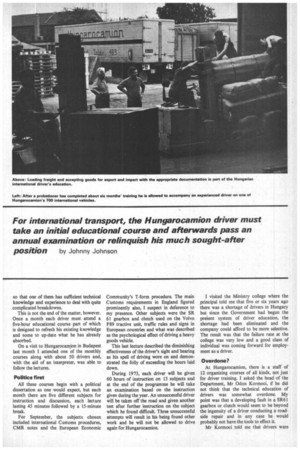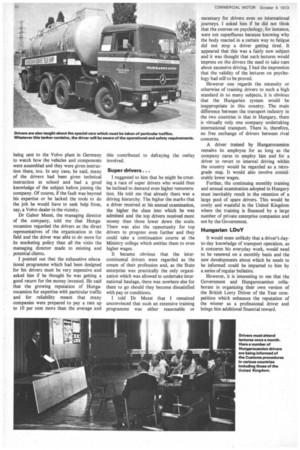HUNGARY IS WHERE A DRIVER'S TRAINING NIEVEVI ENDS
Page 52

Page 53

Page 54

If you've noticed an error in this article please click here to report it so we can fix it.
THE VALUE of a good well-trained driver cannot be disputed and, in Britain, the Road Transport Industry Training Board lays down a programme of driver training which it considers to be adequate. Apart from recommended refresher courses, it is assumed that the skills a driver learns remain with him during his working life and, because he uses them virtually every day they are considered to become almost second nature.
Not so in Hungary, however — certainly not for the driver who is engaged on international transport. There, the State-controlled international road transport undertaking Hungarocamion subjects its drivers to a training programme which would make the average British driver's hair stand on end and follows, this up with a monthly educational course and annual examination on which the driver's job depends.
Though a driver may drive a heavy goods vehicle inside Hungary at 18 years of age, he is not allowed to join the international field with Hungarocamion (which operates throughout Europe, and beyond) until he is at least 25 and there is an upper age limit for recruitment at 45. He must also have six years' experience of truck driving.
Aptitude tests
Selection for employment with Hungarocamion is by interview during which the applicant's education, personal characteristics and geographical knowledge is assessed. If he is selected for employment he attends two 2-hour lectures on road safety and fire prevention and has to pass aptitude and psychological tests. He is then allowed to work in the company's garage for six to eight months during which his initial driver's training is undertaken.
He must first attend a five-week course at the college run by the Ministry of Traffic and Telecommunication under which department Hungarocatnion operates. Here he is instructed in three main subjects in which he must pass an examination which is critical to his continued employment. These comprise international trade and traffic knowledge, technical subjects concerned with vehicle operation and maintenance, and international Customs procedures.
There are also other subjects to learn but he is not examined on these and success or failure to grasp them does not jeopardise his chances of driving employment.
. On-the-job training during his initial employment period includes driving training, instruction on the technical differences between Volvo, Scania and the Hungarian produced Raba-Mann vehicles and how to accept goods for transport in different countries together with appropriate documentation.
On successful completion of the probationary period, probationers are then detailed to accompany an experienced driver until they achieve the required standard.
This double manning presents no difficulty during the company's normal operation for, with about 1600 drivers to 700 vehicles, the company's policy is to have two drivers on each international journey so that one of them has sufficient technical knowledge and experience to deal with quite complicated breakdowns.
This is not the end of the matter, however. Once a month each driver must attend a five-hour educational course part of which is designed to refresh his existing knowledge and some to up-date what he has already absorbed.
On a visit to Hungarocamion in Budapest last month I attended one of the monthly courses along with about 50 drivers and, with the aid of an interpreter, was able to follow the lectures, Politics first All these courses begin with a political dissertation as one would expect, but each month there are five different subjects for instruction and discussion, each lecture lasting 45 minutes followed by a 15-minute break.
For September, the subjects chosen included international Customs procedures, CMR notes and the European Economic Community's T-form procedure. The main Customs requirements in England figured prominently also, I suspect in deference to my presence. Other subjects were the SR 61 gearbox and clutch used on the Volvo F89 tractive unit, traffic rules and signs in European countries and what was described as the psychological effect of driving a heavy goods vehicle.
This last lecture described the diminishing effectiveness of the driver's sight and hearing as his spell of driving wore on and demonstrated the folly of exceeding the hours laid down.
During 1973, each driver will be given 60 hours of instruction on 13 subjects and at the end of the programme he will take an examination based on the instruction given during the year. An unsuccessful driver will be taken off the road and given another test after further instruction on the subject which he found difficult. Three unsuccessful attempts will result in his being found other work and he will not be allowed to drive again for Hungarocamion. I visited the Ministry college where the principal told me that five or six years ago there was a shortage of drivers in Hungary but since the Government had begun the preSent system of driver education, the shortage had been eliminated and the company could afford to be more selective. The result was that the failure rate at the college was very low and a good class of individual was coming forward for employment as a driver.
Overdone?
At Hungarocamion, there is a staff of 12 organizing courses of all kinds, not just for driver training. I asked the head of the Department, Mr Odon Kormoci, if he did not think that the technical education of drivers was somewhat overdone. My point was that a developing fault in a SR61 gearbox or clutch would seem to be beyond the ingenuity of a driver conducting a roadside repair and in any case he would probably not have the tools to effect it.
Mr Kormoci told me that drivers were beingsent to the Volvo plant in Germany to watch how the vehicles and components were assembled and they were given instruction there, too. In any case, he said, many of the drivers had been given technical instruction at school and had a good knowledge of the subject before joining the company. Of course, if the fault was beyond his expertise or he lacked the tools to do the job he would have to seek help from, say, a Volvo dealer in the vicinity.
Dr Gabor Mezei, the managing director of the company, told me that Hungarocamion regarded the drivers as the direct representatives of the organization in the field and the driver was able to do more for its marketing policy than all the visits the managing director made to existing and potential clients.
I pointed out that the exhaustive educational programme which had been designed for his drivers must be very expensive and asked him if he thought he was getting a good return for the money invested. He said that the growing reputation of Hungarocamion for expertise with particular traffic and for reliability meant that many companies were prepared to pay a rate up to 10 per cent more than the average and this contributed to defraying the outlay involved.
Super drivers ...
I suggested to him that he might be creating a race of super drivers who would then be inclined to demand even higher remuneration. He told me that already there was a driving hierarchy. The higher the marks that a driver received at his annual examination, the higher the class into which he was admitted and the top drivers received more money than those lower down the scale. There was also the opportunity for top drivers to progress even further and they could take a continuation course at the Ministry college which entitles them to even higher wages.
It became obvious that the intercontinental drivers were regarded as the cream of their profession and, as the State enterprise was practically the only organization which was allowed to undertake international haulage, there was nowhere else for them to go should they become dissatisfied with pay or conditions.
I told Dr Mezei that I remained unconvinced that such an extensive training programme was either reasonable or necessary for drivers even on international journeys. I asked him if he did not think that the courses on psychology, for instance, were not superfluous because knowing why the body reacted in a certain way to fatigue did not stop a driver getting tired. It appeared that this was a fairly new subject and it was thought that such lectures would impress on the drivers the need to take care about excessive driving. I had the impression that the validity of the lectures on psychology had still to be proved.
However one regards the necessity or otherwise of training drivers to such a high standard in so many subjects, it is obvious that the Hungarian system would be inappropriate in this country. The main difference between the transport industry in the two countries is that in Hungary, there is virtually only one company undertaking international transport. There is, therefore, no free exchange of drivers between rival concerns.
A driver trained by Hungarocamion remains its employee for as long as the company cares to employ him and for a driver to revert to internal driving within the country would be regarded as a retrograde step. It would also involve considerably lower wages.
Further, the continuing monthly training and annual examination adopted in Hungary must inevitably result in the retention of a large pool of spare drivers. This would be costly and wasteful in the United Kingdom where the training is financed by a large number of private enterprise companies and not by the Government.
Hungarian LDoY It would seem unlikely that a driver's dayto-day knowledge of transport operation, as it concerns his everyday work, would need to be renewed on a monthly basis and the new developments about which he needs to be informed could be imparted to him by a series of regular bulletins.
However, it is interesting to see that the Government and Hungarocamion collaborate in organizing their own version of the British Lorry Driver of the Year competition which enhances the reputation of the winner as a professional driver and brings him additional financial reward.
















































































































































